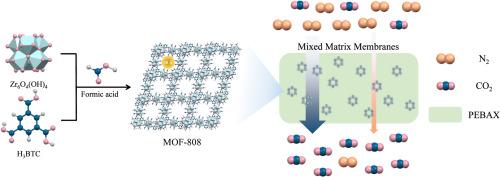调整MOF-808中的连接缺陷,以改善混合基质膜中的CO2分离
IF 9
1区 工程技术
Q1 ENGINEERING, CHEMICAL
引用次数: 0
摘要
碳捕获被广泛认为是缓解全球变暖加速影响的关键技术。嵌入金属有机框架(mof)的混合基质膜(MMMs)为高性能分离提供了一条引人注目的途径,MOF-808因其出色的化学稳定性和环保合成而脱颖而出。在本研究中,通过改变甲酸调制器来调节MOF-808的缺陷密度:较高的调制器负载使MOF-808具有较高的连接器缺陷密度。合成后,用水或乙醇洗涤MOF-808,然后通过无干燥工艺将其掺入PEBAX基质中,以确保分散均匀。乙醇洗涤改变了MOF-808的孔隙配位环境,部分取代甲酸酯。加入适量的甲酸可以产生额外的开放金属位点,提高CO2渗透率和CO2/N2选择性;然而,过量的甲酸会产生过多的缺陷,造成严重的孔隙堵塞,从而降低CO2渗透率。无干燥方法通过防止MOF聚集和确保均匀分散,使CO2/N2选择性比常规干燥方法提高了38%。乙醇洗涤引起的乙氧基取代占据了部分孔隙体积,导致CO2渗透率降低。优化后的MOF-808/PEBAX MMM的CO2渗透率为150 Barrer, CO2/N2选择性为76.4,均显著高于原始聚合物。这些结果强调了一种可持续的、可扩展的策略,用于生产用于燃烧后二氧化碳捕获的高效膜。本文章由计算机程序翻译,如有差异,请以英文原文为准。

Tailoring linker defects in MOF-808 to improve CO2 separation in mixed matrix membranes
Carbon capture is widely recognized as a pivotal technology for alleviating the accelerating impacts of global warming. Mixed matrix membranes (MMMs) that embed metal organic frameworks (MOFs) offer a compelling route to high-performance separations, and MOF-808 stands out among them because of its outstanding chemical stability and environmentally friendly synthesis. In this study, the defect density of MOF-808 was tuned by varying the formic acid modulator: Higher modulator loading produced MOF-808 with higher linker defect density. After synthesis, MOF-808 was washed with either water or ethanol and then incorporated into PEBAX matrix through a drying-free process that ensured uniform dispersion. Washing with ethanol altered the pore coordination environment of MOF-808, partially replacing formate with ethoxide. Introducing an appropriate amount of formic acid created additional open metal sites and increased both CO2 permeability and CO2/N2 selectivity; however, excessive formic acid produced too many defects, causing severe pore blockage and consequently lowering the CO2 permeability. The drying-free method, by preventing MOF aggregation and ensuring homogeneous dispersion, led to a 38 % increase in CO2/N2 selectivity compared with the conventional drying method. The ethoxide substitution induced by ethanol washing occupied part of the pore volume, leading to a reduction in CO2 permeability. The optimized MOF-808/PEBAX MMM achieved a CO2 permeability of 150 Barrer and a CO2/N2 selectivity of 76.4, both markedly higher than those of the pristine polymer. These results highlight a sustainable, scalable strategy for producing high-efficiency membranes for post-combustion CO2 capture.
求助全文
通过发布文献求助,成功后即可免费获取论文全文。
去求助
来源期刊

Journal of Membrane Science
工程技术-高分子科学
CiteScore
17.10
自引率
17.90%
发文量
1031
审稿时长
2.5 months
期刊介绍:
The Journal of Membrane Science is a publication that focuses on membrane systems and is aimed at academic and industrial chemists, chemical engineers, materials scientists, and membranologists. It publishes original research and reviews on various aspects of membrane transport, membrane formation/structure, fouling, module/process design, and processes/applications. The journal primarily focuses on the structure, function, and performance of non-biological membranes but also includes papers that relate to biological membranes. The Journal of Membrane Science publishes Full Text Papers, State-of-the-Art Reviews, Letters to the Editor, and Perspectives.
 求助内容:
求助内容: 应助结果提醒方式:
应助结果提醒方式:


